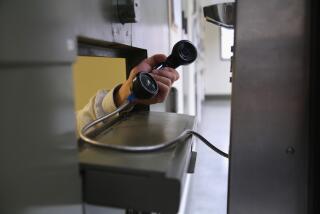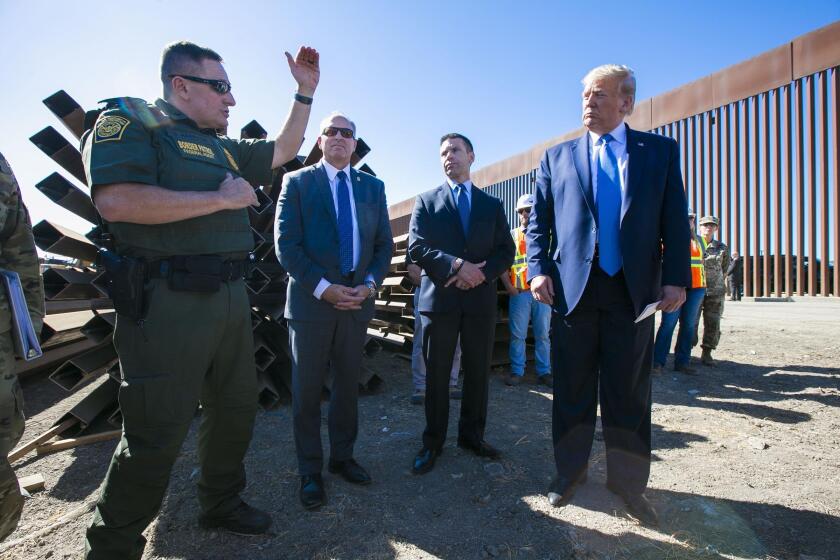ICE arrests in courtrooms escalate feud between California and Trump administration over immigration policy
Reporting from SACRAMENTO — Yovanny Ontiveros-Cebreros arrived at the Sacramento courthouse expecting to plead not guilty to felony drug charges and be allowed to go home. His attorney had said that was standard procedure.
Instead, an immigration agent approached the 38-year-old after his arraignment and put him in handcuffs, saying he was wanted for unlawful reentry into the United States.
With the Trump administration pushing for speedier deportations and hard-line immigration enforcement, California officials have tried to ensure that state courthouses — along with schools and hospitals — remain “safe zones” so that witnesses and crime victims, among others, won’t be afraid to come forward.
Immigration and Customs Enforcement officials maintain that making arrests in court in some ways is preferable because it provides a secure environment, where there’s no risk their target will be armed. ICE officials place the blame for more frequent arrests being made in courthouses on the policy meant to stop that from happening: California’s landmark “sanctuary” law.
While Ontiveros-Cebreros faced serious criminal charges, his arrest last week reignited protests from immigrant advocates as well as some judges.
California Supreme Court Chief Justice Tani G. Cantil-Sakauye, who has emerged as a leading critic of ICE’s courtroom presence, said in a statement Monday that the arrests were “disruptive, shortsighted, and counterproductive.… It is damaging to community safety and disrespects the state court system.”
The latest Sacramento arrest is expected to add urgency to a bill by Sen. Ricardo Lara (D-Bell Gardens), which would prohibit federal immigration agents from entering schools, courthouses and state buildings to arrest or question people without a warrant. Retired judges, law professors and activists working with the nonprofit Legal Aid at Work have proposed a broader statewide courthouse rule to be considered by the Judicial Council of California in the fall.
The rule would block any civil arrests inside courthouses, saying they are and should be “places where anyone can come to seek help or to testify without fear.”
ICE does not statistically track arrests by location and it is unclear just how many have taken place inside courthouses. However, immigration officials argue that California’s sanctuary law aimed at protecting immigrants here illegally has already made it harder for them to arrest detainees at county jails, forcing them into places like courthouses.
Signed by Gov. Jerry Brown last year and now being challenged in court by the Trump administration, the law was part of a broader effort by majority Democrats in the state Legislature to shield more than 2.3 million immigrants living illegally in California.
It placed new limits on law enforcement agencies to prevent them from holding, questioning and arresting more, if not most, people at the request of federal immigration authorities. ICE officials now say many local law enforcement agencies refuse their requests to hold immigrants or communicate inmates’ dates of release from custody.
“ICE will continue to use all other available methods to apprehend individuals when we know their expected locations — like at courthouses,” the agency said in a statement.
But state leaders and immigrant rights groups contend that recent courthouse arrests underscore how ICE and some sheriffs — most of whom vehemently opposed the sanctuary state law — are continuing to find ways to circumvent it.
Concerns over the arrests had been on the rise nationwide long before California passed its sanctuary law. Attorneys and prosecutors in California, Arizona, Texas and Colorado last year all reported teams of ICE agents — some in uniform, some not — sweeping into courtrooms or waiting outside court complexes to arrest immigrants who are in the country illegally.
In California, the impact has perhaps been most pronounced recently in Fresno, where local Republican Party leaders have sought advice on how to challenge the sanctuary law and Sheriff Margaret Mims has been looking for ways to increase collaboration with ICE in the wake of the new restrictions on how local authorities can work with the agency.
The city “went from having zero enforcement at courthouses in recent years to having ICE arrests on a weekly basis in recent weeks,” said Grisel Ruiz, a staff attorney at Immigrant Legal Resource Center in Sacramento.
Related: Under Trump, the rare act of denaturalizing U.S. citizens on the rise »
Tony Botti, a spokesman for the Fresno County sheriff’s office, argued that ICE is not the only federal agency to conduct investigations or arrests inside courthouses. Sheriff deputies don’t coordinate or get involved, he said.
“Despite the complaints, it is not our place to intervene and get in the way of a law enforcement agent from doing their job,” he said.
ICE said it made the arrest at the Sacramento superior courthouse “pursuant to a criminal arrest warrant issued by a Federal Magistrate Judge.” Because it is an ongoing federal criminal case, “no additional information is available at this time,” the agency said in a statement.
Although ICE directs its agents to avoid making arrests in “sensitive locations,” including schools, places of worship and hospitals, the agency does not consider courthouses to fall into that category.
In January, ICE issued a formal, public policy memo on immigration enforcement actions inside courthouses, making it clear that agents would not make arrests indiscriminately. Inside courthouses, agents can arrest specific, targeted immigrants who have committed crimes, are gang members, pose national security or public safety threats, have been ordered removed but failed to leave, or who have reentered the country illegally after being removed.
Entering a courthouse does not make one “exempt from law enforcement,” said Mark Krikorian, executive director of the Center for Immigration Studies, which supports tighter controls.
“The reason ICE has to do arrests on the street or in courthouses or other public places is precisely because the anti-border jurisdictions have prevented them from doing it in a safe, controlled environment in the county jails,” Krikorian said. “These sanctuary jurisdictions are creating the very problem they’re complaining about.”
It was through the sanctuary law that state lawmakers first sought to create safe zones for people who are in the country illegally: They tasked the California attorney general with developing policies by October to help curb immigration enforcement at courthouses and other public institutions. Those places will only be encouraged — not required — to adopt the attorney general’s policies.
There is some debate whether the arrest of Ontiveros-Cebreros, who was facing charges of possession of a controlled substance and possession of a controlled substance for sale, violates the sanctuary law. Some immigrant rights groups say it goes against the spirit of the policies.
But staffers with the office of Sen. Kevin de León (D-Los Angeles), who wrote the law, on Monday said the arrest would violate the state law only if there were no criminal charge justifying it.
Regardless, Ontiveros-Cebreros’ attorney said the arrest has a chilling effect.
“There’s only one way in and out of the courtroom for the public, and that’s the front door,” said Charles Pacheco. “You figure out who the guy is, you wait outside in the hallway; you can make your arrest there. But in the courtroom? … We protect our clients, and I’ll tell you what, I’ll never walk a client of mine into a trap again.”
Sheriffs oversee jails and security at courthouses, wielding tremendous power over the implementation of the sanctuary law and over a county’s cooperation with ICE in general.
In Sacramento, county Sheriff Scott Jones asked President Trump’s immigration chief for help fighting California’s sanctuary law before it was enacted and hosted a town-hall meeting in March on immigration enforcement that drew hundreds of people and erupted in protests.
The Sacramento County Sheriff’s Department referred questions about last Wednesday’s arrest to ICE.
On Monday, Sacramento County Superior Court Presiding Judge David De Alba issued a statement calling arrests inside a courthouse, and “especially inside of a courtroom,” as “disruptive of courtroom proceedings.”
“As the Presiding Judge of the Sacramento County Superior Court, I do not like what happened last week and will work with the local sheriff and, if necessary, with ICE representatives, to avoid this from happening again,” De Alba said. “Judges should decide what happens in their courtrooms, not ICE.”
More to Read
Sign up for Essential California
The most important California stories and recommendations in your inbox every morning.
You may occasionally receive promotional content from the Los Angeles Times.












